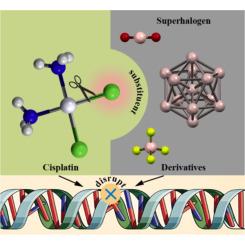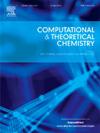Mono-substituent effect of Al13, BO2, and BF4 superhalogens on the structure, electronic properties, and chemical reactivity of cisplatin: A DFT study
IF 3
3区 化学
Q3 CHEMISTRY, PHYSICAL
引用次数: 0
Abstract
Substituting the ligands of cisplatin is recognized as a significant strategy to create new platinum-based antitumor drugs. In this study, the mono-substituent effect of three typical superhalogens, namely Al13, BO2, and BF4, on the structure, electronic properties, and chemical reactivity of cisplatin has been investigated with the assistance of density functional theory (DFT). The mono-substitution of superhalogens for one chlorine ligand of cisplatin results in the formation of a weakly polar covalent bond in Pt-Al13 and the strong polar covalent bonds in Pt-BO2 and Pt-BF4. Interestingly, the energy barriers for the hydrolysis of superhalogen ligands of Pt-BO2 and Pt-BF4 are lower than that for the hydrolysis of Cl ligand of cisplatin, suggesting that these two derivatives may have enhanced biological activity. Thereby, this study provides a superhalogen-substituent strategy to develop analogues of cisplatin with improved anticancer activity from a theoretical point of view.

Al13、BO2和BF4超卤素对顺铂结构、电子性质和化学反应性的单取代效应:DFT研究
取代顺铂的配体被认为是开发新型铂基抗肿瘤药物的重要策略。本研究利用密度泛函理论(DFT)研究了三种典型的超卤素Al13、BO2和BF4对顺铂的结构、电子性质和化学反应性的单取代效应。顺铂的超卤素单取代一个氯配体导致Pt-Al13形成弱极性共价键,Pt-BO2和Pt-BF4形成强极性共价键。有趣的是,Pt-BO2和Pt-BF4的超卤素配体水解的能垒低于顺铂的Cl配体水解的能垒,这表明这两种衍生物可能具有增强的生物活性。因此,本研究从理论角度提供了一种超卤素取代基策略来开发具有更好抗癌活性的顺铂类似物。
本文章由计算机程序翻译,如有差异,请以英文原文为准。
求助全文
约1分钟内获得全文
求助全文
来源期刊

Computational and Theoretical Chemistry
CHEMISTRY, PHYSICAL-
CiteScore
4.20
自引率
10.70%
发文量
331
审稿时长
31 days
期刊介绍:
Computational and Theoretical Chemistry publishes high quality, original reports of significance in computational and theoretical chemistry including those that deal with problems of structure, properties, energetics, weak interactions, reaction mechanisms, catalysis, and reaction rates involving atoms, molecules, clusters, surfaces, and bulk matter.
 求助内容:
求助内容: 应助结果提醒方式:
应助结果提醒方式:


